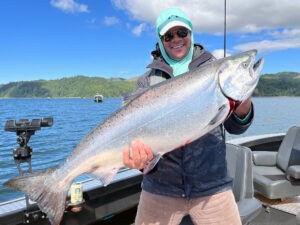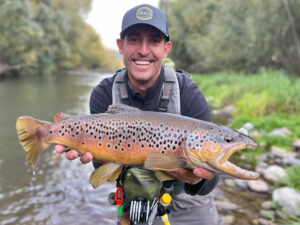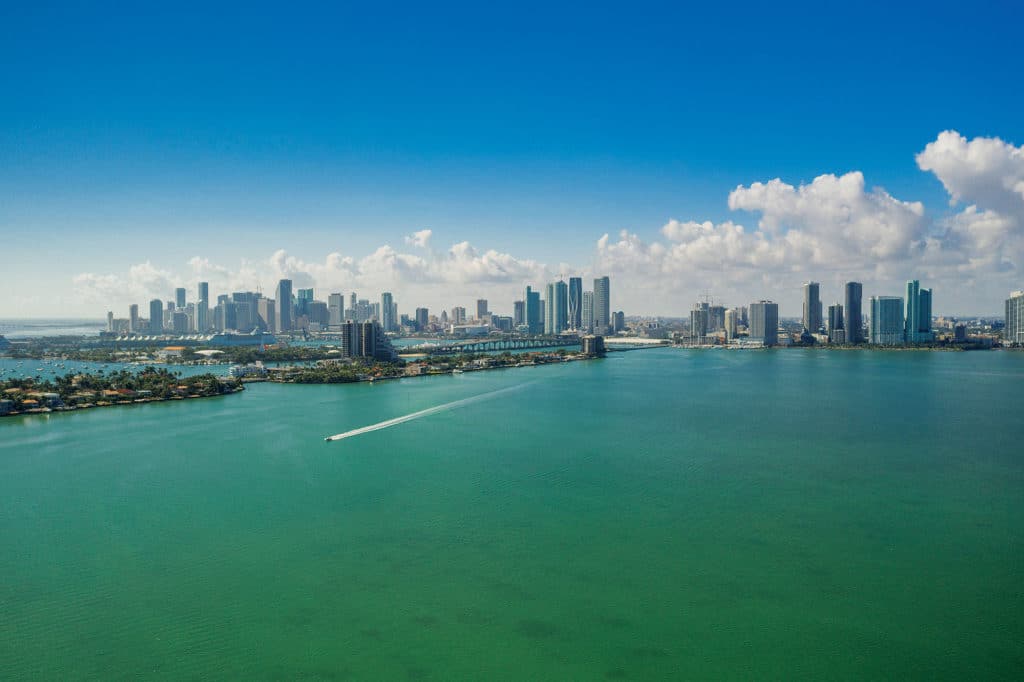
Here he comes! my mind screamed. But I held my tongue: I didn’t want to spook the fish or my nephew, Hunter Salyers. Coming straight toward us was an overslot redfish, as subtle as an 18-wheeler rolling through South Beach. Hunter held a 10-pound spin outfit armed with a righteous blue crab, prepped just in case we came across one of Biscayne Bay’s rare, albeit hero, redfish. His finesse, 10-foot straight-on touch cast landed perfectly as the fish surfaced only 20 feet ahead. We had done our part to get the bite this mid-October morning; the rest was up to the fish.
Hunter crouched on the casting platform to avoid detection as I steadied the boat. The redfish submerged where the crab had fallen. I couldn’t see the hookup through Hunter’s wide frame, but once he stood up, I saw the rod bend. From my perspective, the bruiser red had taken total control, pulling drag, swimming left, then right, in close quarters near the mouth of a creek. The fish broke left again, heading toward a menacing mangrove point.
This time I was wasn’t so silent. “Stop him now, Hunter!” I yelled, as I leaned hard on the push pole, changing the skiff’s angle. Hunter held the rod low and turned the fish’s head just enough to alter its path. However, from my previous experiences with these bulls, I knew this battle was long from over.
The red looped around, and with a full head of steam, swam right for the mangrove canopy. The 20-pound fluorocarbon leader parted. Oh well, I mused, we’ll just have to be happy with our snook and snapper—all in a half-day of fishing south Biscayne Bay.
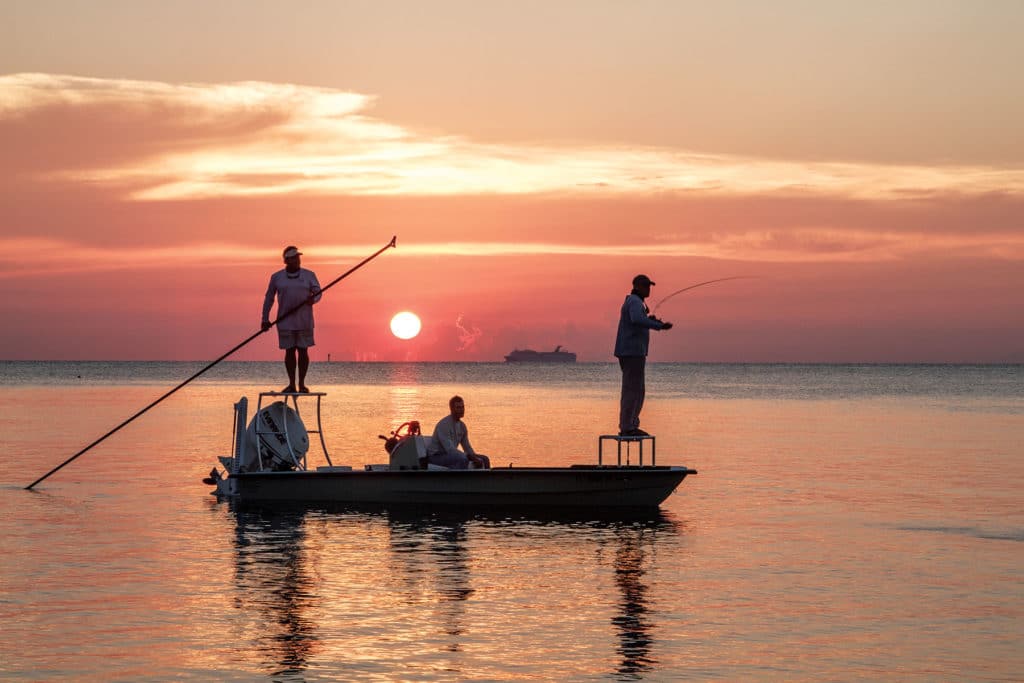
Beauty and the Beast
If you like shallow-water inshore fishing, Miami’s Biscayne Bay can certainly spoil you. Hip, urban, glitzy Miami—known for its beaches, clubs and skyline—also hosts a natural crown jewel that lies just to the east. This magnificent bay not only accents Miami’s world-class resort atmosphere, but it also offers up unique world-class fishing. As a second-generation Miami native, I am lucky to have fished Biscayne since childhood.
Biscayne stretches from North Miami to Key Largo and encompasses 428 square miles of water (almost the same size as the city of San Antonio). A portion of the bay—270 acres—receives some oversight and protection as part of the Biscayne National Park, which was established in 1980. However, because the bay sits in the shadow of Miami’s ever-growing skyline, it’s also subject to the effects of population density. Minimizing human impacts on Biscayne will be vital to the bay’s future.
For instance, a recent Dade County Department of Environmental Resources Management study showed sea-grass die-offs in various parts of the bay. As a result, the county has recommended improving water quality, habitat monitoring and public awareness, as well as spurring continued restoration activities.
However, the damage is relative. “Compared with other estuaries and coastal waters around Florida, sea grasses in Biscayne Bay are doing quite well,” says Brian Lapointe, research professor and water-quality expert at Harbor Branch Oceanographic Institute in Fort Pierce, Florida. “Both Florida Bay and Indian River Lagoon have suffered severe phytoplankton blooms in recent years, which reduce light,” and ultimately cause low oxygen levels and sea-grass die-off.
While phytoplankton blooms and some sea-grass die-off have occurred in northern Biscayne Bay, the southern bay has remained relatively clean and clear, favorable for sea-grass growth and healthy fisheries habitat.
“The relatively good water quality in southern Biscayne Bay results from very low phosphorus levels that prevent phytoplankton blooms. In addition, southern Biscayne Bay has a high degree of flushing with clean, clear seawater from the nearby Florida Current (in the Gulf Stream system), which dilutes land-based sources of pollution, such as nitrogen. The relatively clean, clear water and healthy sea-grass meadows in southern Biscayne Bay are the reason that fishing in this sweet spot is still very good.”
Indeed, Biscayne still holds a wealth of popular gamefish such as bonefish, tarpon, permit, snapper, mackerel, sharks and even the occasional grouper. Anglers often find it tough to focus on a single target species any given day.
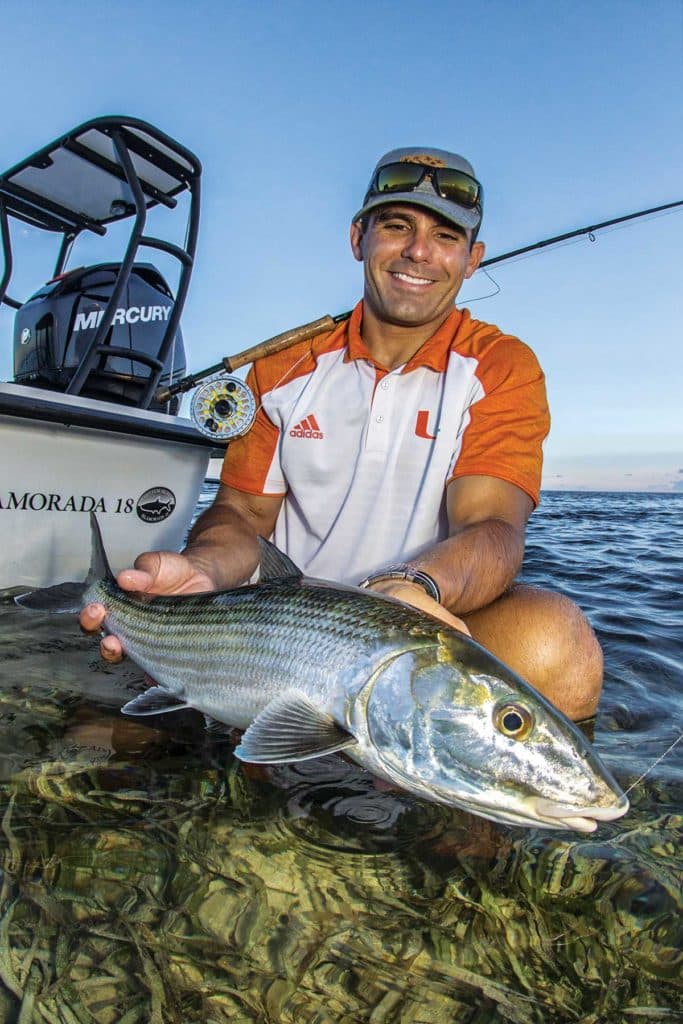
Hero Fish
Local guides and anglers claim that Biscayne Bay bonefish are more skittish than bonefish in the Bahamas or even the Florida Keys. However, the payoff can be worth the time because double‑digit fish can be caught.
Anglers can hunt bones most of the year; however, some bigger fish haunt the west side of Biscayne in winter, where the water stays warmer due to the dark bottom. One of my longtime captain friends, Jorge Valverde (lowplacesguideservice.com), got me out on some cool winter mornings to prove his theory, and he did not disappoint.
Permit can be large enough that their backs show when they’re feeding in just over a foot of water. They’re also famous for appearing and sometimes quickly disappearing on the edge of the finger channels while the tides pour in and out of the bay.
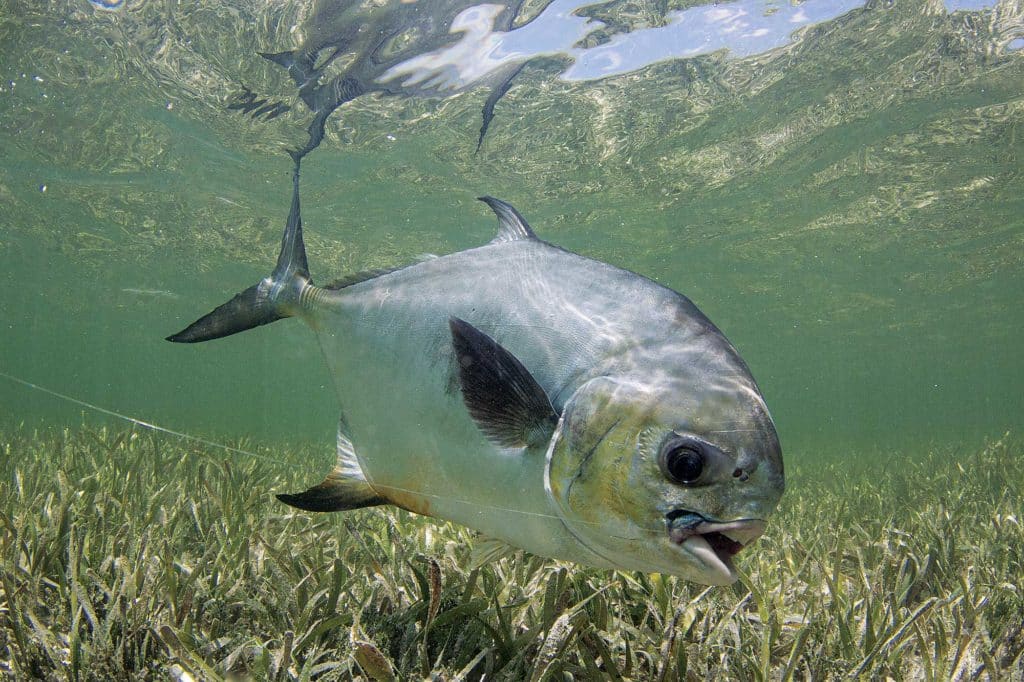
Summer months produce the best opportunities because permit really prefer warm water. However, I must admit that one day this past February, I saw the most permit at one time I’ve seen in 10 years in the waters near Homestead Bayfront Park.
Tarpon swim throughout eastern and western Biscayne before many migrate to the Keys and beyond. Anglers target them around bridges, flats, finger channels and the local inlet—Government Cut. The fish range from north Biscayne west to the tidal creeks and coves, and down to the southern border of Biscayne National Park. Large, triple-digit tarpon migrate south to the Florida Keys in spring.
All three of these hero flats species fall to live or dead shrimp and crab baits. Tarpon can also be taken on pilchards and even big mullet. Some folks choose to fish bones, permit and even tarpon with artificials such as a jig tipped with a piece of dead shrimp. I personally prefer to use mostly live bait with a circle hook sized to match the bait.
Besides the headliners, a few overslot redfish cruise the mangroves in the southwest corners of Biscayne. Snook can be found throughout the region; they seem to borrow tactics from their brethren in the Everglades, where they ambush prey from potholes within the turtle grass. If not using live bait, cast a Rapala Skitter Walk, Bomber Badonk-A-Donk, MirrOlure Top Dog or Yo-Zuri 3D Pencil.
Mutton and mangrove snapper as well as spotted seatrout also make periodic appearances in the bay, enhancing the smorgasbord.
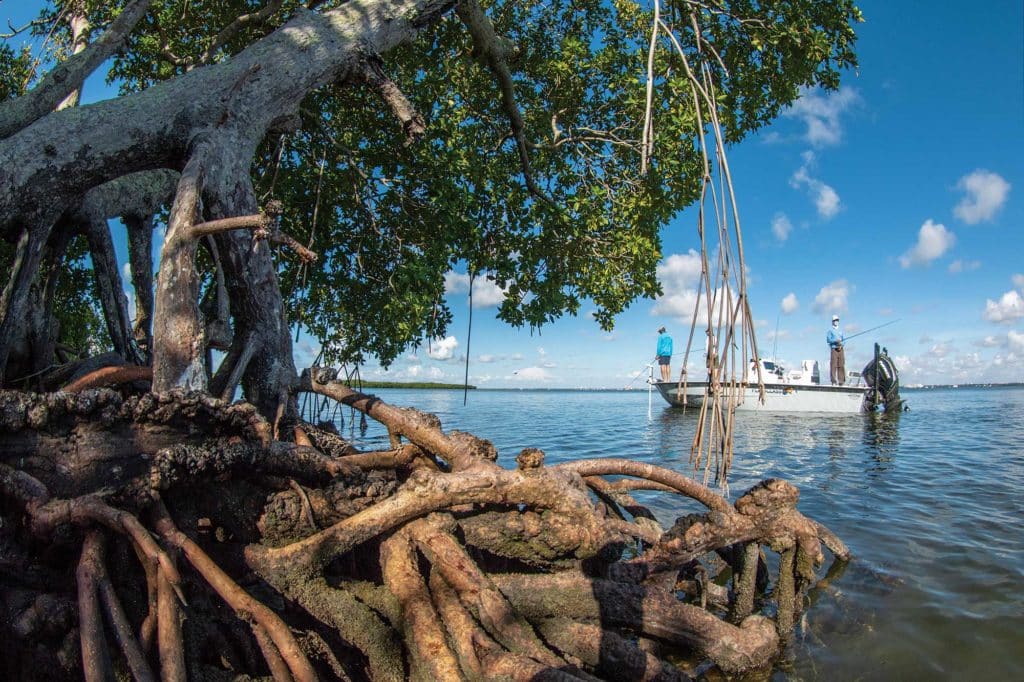
The Pros Know
Fresh water once flowed in sheets from the mainland to the bay, and springs fed Biscayne through the porous limestone aquifer. But today, most natural tributaries have been channelized to facilitate water flow away from the city.
Capt. Joe Gonzalez (captainjoegonzalez.com), one of the region’s most respected guides, has fished south Biscayne Bay (Rickenbacker Causeway to North Key Largo) since 1987, and he has seen many changes. Gonzalez says that although the fishing’s not what it used to be, the ecosystem still seems healthy, due to the nearby Gulf Stream, as Lapointe also suggested.
Well-known Miami captain Bouncer Smith (captbouncer.com) has fished the bay since 1956. My first trip with him dates back more than 20 years, when he took Ariel Pared, president of SeaVee Boats, and me to Dumfounding Bay, north of Biscayne. We wore out ambitious and acrobatic juvenile tarpon to 50 pounds by just floating shrimp back from the boat on medium‑size spinning outfits.
Sparsely populated south Biscayne garners most of the accolades from today’s anglers, but north Biscayne still produces snook, tarpon, seatrout, bonefish and permit. Its backdrop looks decidedly different, with developed tall office and condo buildings that rise dramatically from this sea-level city.
Read Next: Tarpon Fishing in Miami at Night
In a strange way, development has also helped anglers target some species—bridge-fishing for tarpon, for instance. I’ve fished with captains, such as Dave Kostyo (knotnancy.com) on Knot Nancy, who are specialists in targeting these tarpon that hang in the bridge shadows. With his trained eye, he sight-fishes tarpon at night, as they move up and down the shadow line.
The tidal flow through Government Cut funnels bait and fish to north and south Biscayne. Smith finds good grouper fishing in the cut, but he quickly points out that dredging in and around the busy commercial Port of Miami adversely affects the fishing.
Although bait species might be less affected, other fish such as bluefish, trout, ladyfish and snapper are slow to rebound. Among Smith’s pet peeves is the damage from dredging and other detrimental human events that turn grass flats into giant sandbars.
“I would also like the park service to stop removing wrecks covered with marine growth,” he adds, explaining that inshore structure—whether introduced or accidental—has become marine habitat and part of the ecosystem.
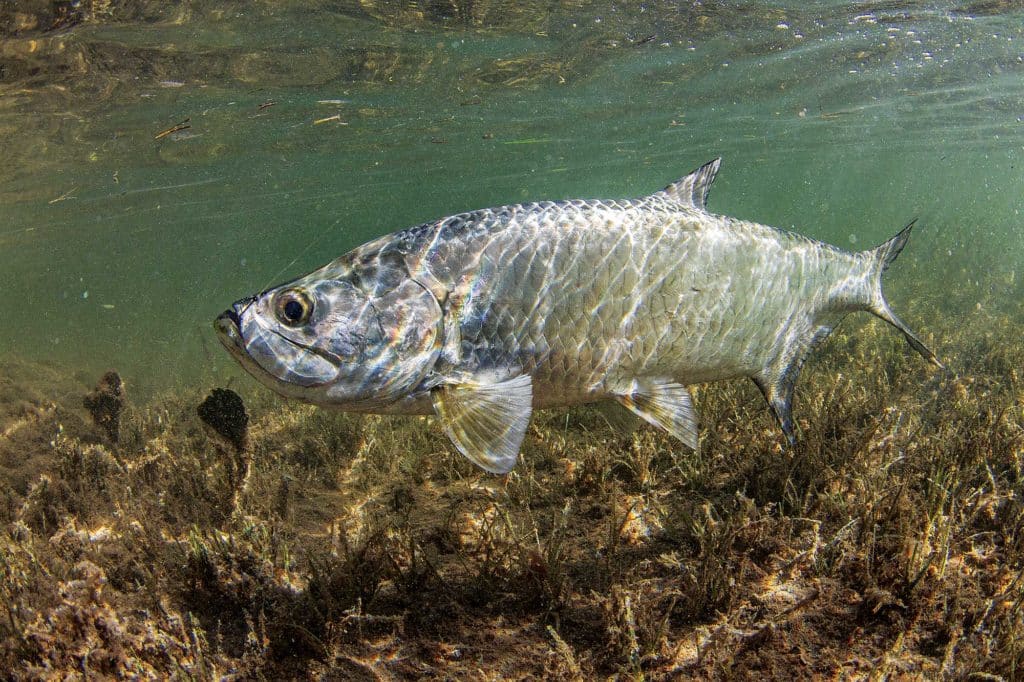
Locked and Loaded
Fishing Biscayne’s diverse fishery means preparing for multiple species at any given time. When fishing my Yellowfin skiff, I try to keep at hand a silver-dollar-size crab on a light 10-pound spin outfit, a shrimp on an 8-pound outfit, and usually some sort of topwater lure on a 12-pound rig. Yes, my boat deck might seem littered with rods, but I never know what species might show.
Just this past winter, on Capt. Jimbo Thomas’ 25 Contender (thom2187@comcast.net), we were targeting snook in a tidal creek. Usually it’s like ringing the dinner bell when you have nice pilchards as we did, but the snook were not cooperating. We drifted the mouth of the creek only to see a school of permit swim right alongside the boat. With no crabs to pitch to them, we could only watch them as they cruised by unafraid. Although my natural instinct was to throw something—anything—at them, we did not have the right ammunition.
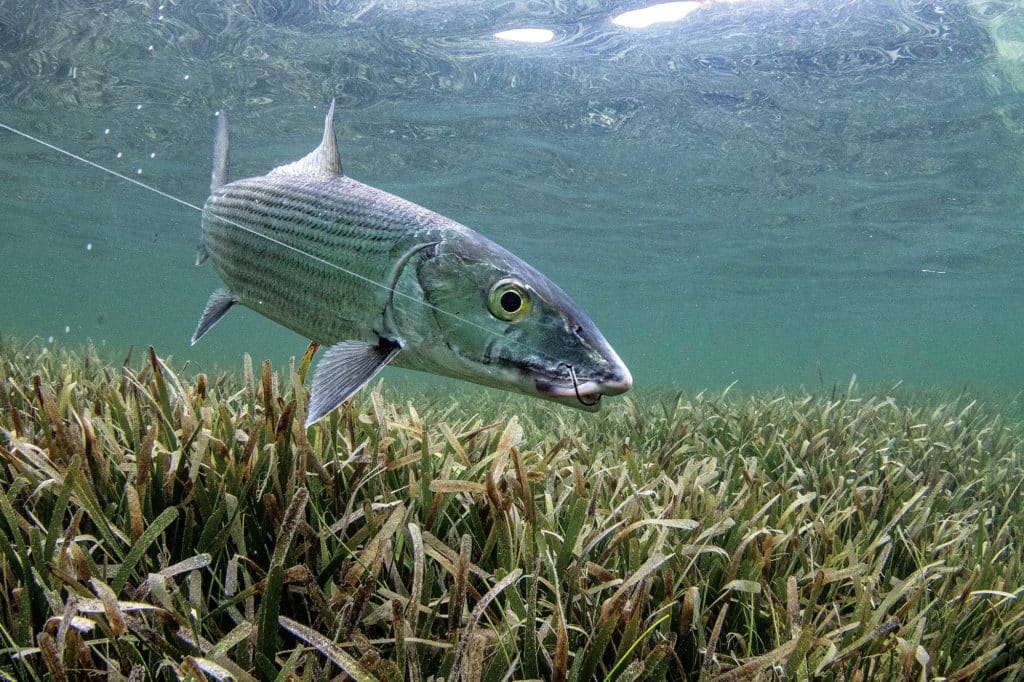
To bring home the point, Hunter (my aforementioned nephew) sent me a barrage of text messages one late afternoon this past spring. Apparently, he had found some bones near Soldier Key’s finger channels. When he flipped a crab into the school of tailing fish, he saw the wake of what he thought would be a bonefish attempting to pounce on his bait. However, much to his surprise, a nice 12-pound mutton snapper charged the crab, and basically stole the bone’s meal in less than a foot of water.
Earlier this year, I fished the Ha Ha Working Man’s Tarpon Tournament, billed as a gentlemen’s tournament (though it seems to be more of an excuse to fish after work three of four nights). On our final evening aboard Tait Keon’s Yamaha-powered 27-foot Contender, we decided to fish off a local haunt called Hobie Beach on Key Biscayne. It features a shallow contour that drops from a depth of 4 feet to 8 feet and holds fish on its edge. Keon’s move proved successful as the bites came fast and furious on our spread of shrimp, crabs and live mullet—all hanging from kites.
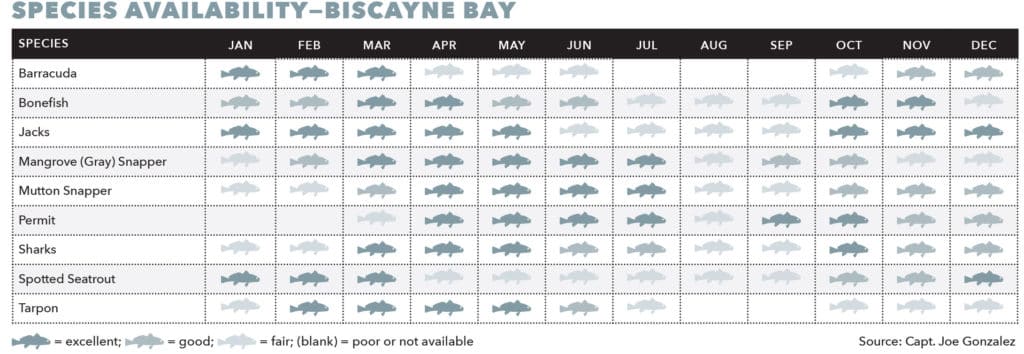
Angler Carlos Carbonell put us on the board, tangling with an 80-plus-pound poon. The rest of the fleet found similar hot fishing, recording catches of tarpon, permit and big jack crevalle.
That early evening, as the tournament came to a close, with the sun setting over the beautiful, twinkling Miami skyline, I was reminded why those who fish Biscayne are forever grateful for the experience: There is truly no other place like it on the planet, where so many have world‑class fishing so close to home.



